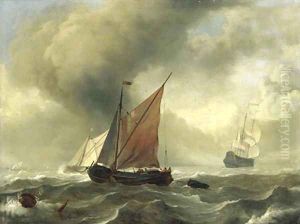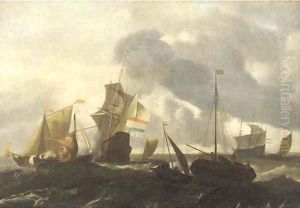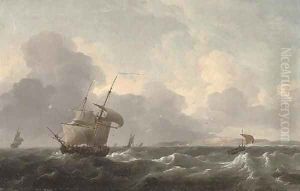Ludolf Backhuizen Paintings
Ludolf Backhuizen was a prominent Dutch painter and printmaker known for his masterful maritime scenes, capturing the dynamic and powerful essence of the sea. Born on December 28, 1630, in Emden, East Frisia (now Germany), Backhuizen moved to Amsterdam in his early twenties, where he would spend the majority of his life and career. This period was the Golden Age of Dutch painting, a time when art, science, trade, and the Dutch navy were among the most acclaimed in the world.
Backhuizen was initially trained in calligraphy, but he soon shifted his focus to painting, studying under Allart van Everdingen and Hendrick Dubbels, artists known for their seascapes and maritime subjects. This training laid the foundation for Backhuizen's future work, which predominantly featured ships and sea battles, reflecting the Dutch Republic's naval power and maritime interests.
His work is characterized by meticulous attention to detail, particularly in the depiction of ships and their rigging, and a masterful use of light and shadow, giving his seascapes a dramatic and almost theatrical quality. Backhuizen's paintings often portrayed specific historical events, including naval battles and significant maritime incidents, making him a sort of visual historian of the Dutch maritime prowess.
Ludolf Backhuizen's reputation grew rapidly, and he became one of the most sought-after maritime painters of his time. His clientele included not only wealthy merchants and naval officers but also European royalty. Beyond painting, Backhuizen also engaged in printmaking, producing etchings that further disseminated his fame.
Despite the high demand for his works, Backhuizen was known to be meticulous and unhurried in his painting process, often working on pieces for long periods to achieve the desired level of detail and atmospheric effect. This dedication to quality over quantity has left a relatively limited, but highly prized, body of work.
Ludolf Backhuizen died on November 17, 1708, in Amsterdam. His legacy endures through his contributions to the Dutch Golden Age of painting, with his works held in high esteem and featured in museum collections around the world, including the Rijksmuseum in Amsterdam and the National Gallery in London. His ability to capture the spirit of the sea and the essence of Dutch maritime achievement has made him an enduring figure in the history of art.


